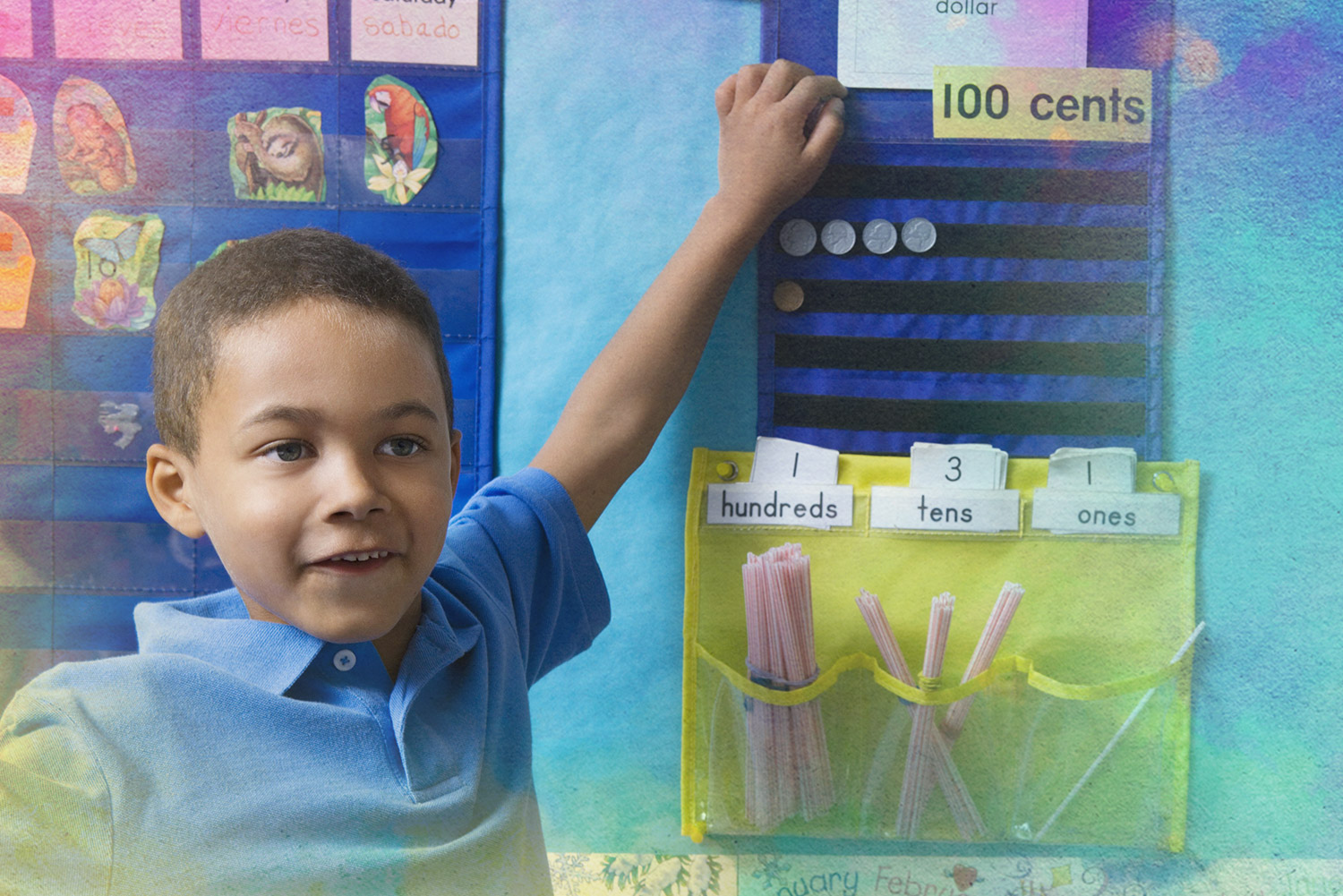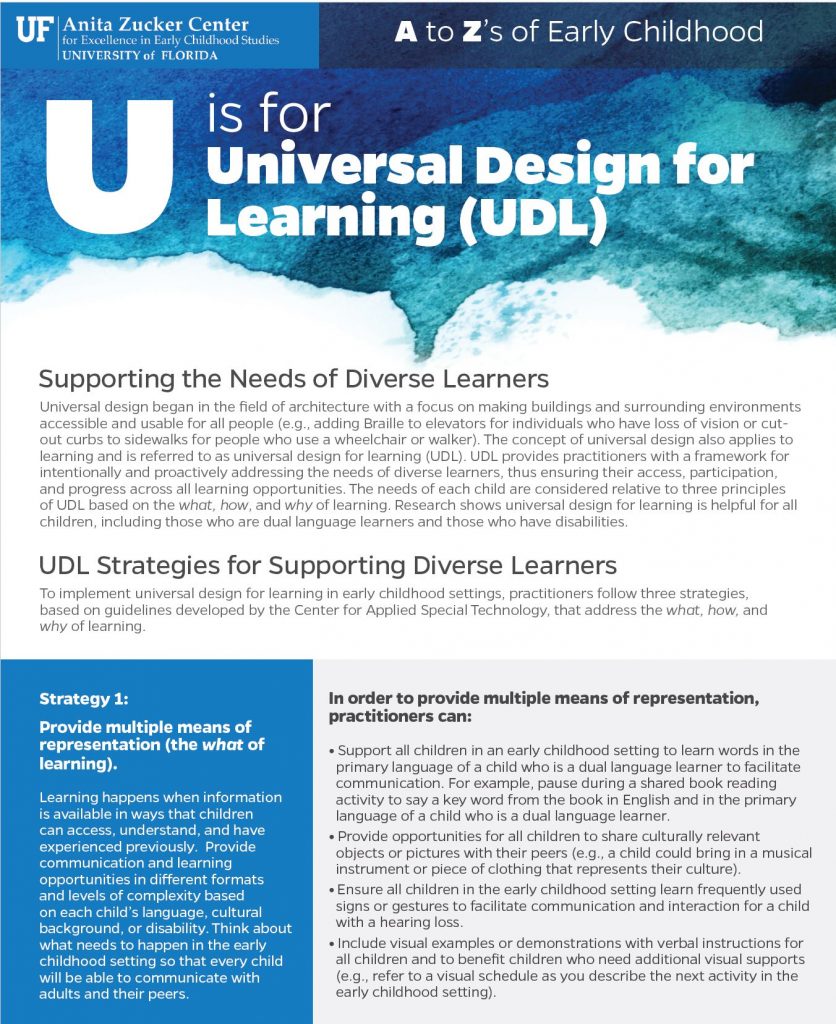A to Z’s of Early Childhood
The Science of Child Development and Learning
U is for Universal Design
Supporting the Needs of Diverse Learners
Universal design began in the field of architecture with a focus on making buildings and surrounding environments accessible and usable for all people (e.g., adding Braille to elevators for individuals who have loss of vision or cut-out curbs to sidewalks for people who use a wheelchair or walker). The concept of universal design also applies to learning and is referred to as universal design for learning (UDL). UDL provides practitioners with a framework for intentionally and proactively addressing the needs of diverse learners, thus ensuring their access, participation, and progress across all learning opportunities. The needs of each child are considered relative to three principles of UDL based on the what, how, and why of learning. Research shows universal design for learning is helpful for all children, including those who are dual language learners and those who have disabilities1.

UDL Strategies for Supporting Diverse Learners
To implement universal design for learning in early childhood settings, practitioners follow three strategies, based on guidelines developed by the Center for Applied Special Technology,2 that address the what, how, and why of learning.
Strategy 1: Provide multiple means of representation (the what of learning).
Learning happens when information is available in ways that children can access, understand, and have experienced previously. Provide communication and learning opportunities in different formats and levels of complexity based on each child’s language, cultural background, or disability. Think about what needs to happen in the early childhood setting so that every child will be able to communicate with adults and their peers.
In order to provide multiple means of representation, practitioners can:
- Support all children in an early childhood setting to learn words in the primary language of a child who is a dual language learner to facilitate communication. For example, pause during a shared book reading activity to say a key word from the book in English and in the primary language of a child who is a dual language learner.
- Provide opportunities for all children to share culturally relevant objects or pictures with their peers (e.g., a child could bring in a musical instrument or piece of clothing that represents their culture).
- Ensure all children in the early childhood setting learn frequently used signs or gestures to facilitate communication and interaction for a child with a hearing loss.
- Include visual examples or demonstrations with verbal instructions for all children and to benefit children who need additional visual supports (e.g., refer to a visual schedule as you describe the next activity in the early childhood setting).
Strategy 2: Provide multiple means of action and expression (the how of learning).
All children need to be able to move independently; engage with objects, toys, and materials in their environment; and communicate with others. These means of action and expression are important for play, social interactions, and learning within an early childhood setting. Think about what needs to happen so that every child is able to participate and learn within their everyday routines and activities.
In order to provide multiple means of action and expression, practitioners can:
- Make changes to the environment to accommodate each child’s physical needs (e.g., add a ramp in addition to stairs and adaptive swings on the playground).
- Arrange centers and furniture so that there is enough space for all children, including a child who uses a wheelchair, to access all areas of the early childhood setting.
- Display a visual daily schedule with pictures that facilitates all children’s understanding and communication about everyday routines and activities, particularly for children who are dual language learners.
- Check in with children regularly during activities to make sure every child understands directions.
Strategy 3: Provide multiple means of engagement (the why of learning).
Children are engaged in learning activities when objects, toys, or materials in the environment attract their attention. Facilitating children’s motivation to engage in exploring and learning is an important part of the why of learning. As you think about universal design and the why of learning, consider learners with diverse needs, either a child whose primary language is not English or a child who might have a disability. Explore ideas about what changes are needed so that every child will be motivated to engage in learning activities.
In order to provide multiple means of engagement, practitioners can:
- Say relevant words and phrases in English for a child who is a dual language learner to facilitate the child’s engagement with materials and others during play activities.
- Organize play with a “play script” so that all children have a role and interact during play.
- Use language to describe materials and activities that are available and interesting to the child and physically orient the child to the location of the materials within the activity and the early childhood setting.
- Establish a routine for increasing each child’s ability to access and engage independently with the materials.
What We Are Doing
The Anita Zucker Center and our collaborators are helping early childhood professionals support the needs of diverse learners through Universal Design for Learning.
Learn More:
Embedded Instruction for Early Learning
Embedded Instruction for Early Learning applies the 3R’s of Early Learning: Relationships, Repetition, Routines ™ to help children and those who interact regularly with them learn important skills during everyday activities with familiar people at home, in early learning programs and in the community. When adults use Embedded Instruction they often apply the three principles of UDL – the what, how, and why of learning.
Embedded Instruction for Early Learning, California
Embedded Instruction for Early Learning California (EIEL-CA) is a partnership between the California Department of Education, Special Education Division, the Desired Results Access Project, and the Anita Zucker Center for Excellence in Early Childhood Studies. EIEL-CA is one way California is supporting practitioners to strengthen the relationship between assessment and instruction. EIEL-CA builds on practitioners’ knowledge and use of the California Curriculuar Frameworks and the Desired Results Developmental Profile, two tools in California which were developed using principles of UDL.
CHILD Center for Early Learning
The Anita Zucker Center partners with local groups, including the Southwest Advocacy Group (SWAG), the Early Learning Coalition of Alachua County, and Episcopal Children’s Services to maintain the CHILD Center for Learning, a model high-quality early care and education demonstration program for young children in Gainesville, FL. Principles of UDL were used to design the CHILD Center and to inform classroom environments, materials, and interactions.
Early Intervention Research Team Awarded IES Grant
The University of Florida’s Anita Zucker Center for Excellence in Early Childhood Studies is advancing research on strategies for supporting preschool children and families through a project led by Dr. Crystal Bishop. “Tools for Families,” fosters collaborative partnerships between teachers and families, enhancing children’s learning experiences both at home and in school, with a particular focus on inclusive preschool education for children with disabilities.
Other Resources
About Universal Design for Learning
Visit this website for a brief overview of Universal Design for Learning framework, including a short video and links for more information on engagement, representation, and action and expression.
The UDL Guidelines
This website by the Center for Applied Special Technology (CAST) details UDL guidelines and how to use them as a tool in the implementation of Universal Design for Learning.
Universal Design for Learning: A Checklist for Early Childhood Environments
Download this checklist of the equipment, tools, and materials educators need to ensure they design the learning environment to be responsive to all children’s needs.
Integrating Principles of Universal Design Into the Early Childhood Curriculum
Read this article about how teachers of young children can ensure all children have meaningful opportunities to learn. It also includes proven and effective implementation recommendations for diverse learning settings.
Universal Design and Outdoor Learning
This article focuses on the importance of outdoor play and learning and the advantages it has for strengthening young children’s connection to nature while promoting learning across different subject areas. It also includes recommendations for incorporating Universal Design for Learning (UDL) principles in outdoor education planning to ensure that all students can participate and stay engaged.
Take a Look! Visual Supports for Learning
This article focuses on visual strategies that are considerate of diverse learners. It includes specific recommendations on visual supports that help children know what to do, learn new skills, and feel included.
Using a Universal Design for Learning Framework to Enhance Engagement in the Early Childhood Classroom
This article from the Journal of Special Education Apprenticeship provides a brief overview of evidence-based UDL practices, with a specific focus on the use of engagement strategies for young children.
Articles by Center Members and Collaborators
- Mayfield, P., McLean, M., & Baird, S. (1993). The effect of signing key words with young children who are hearing impaired. Infant Toddler Intervention, 3(2), 109-118.
- McLean, M. (2002). Assessing young children for whom English is a second language. In M. Ostrosky & E. Horn (Eds.), Assessment: Gathering meaningful information: Young Exceptional Children Monograph Series (No. 4). Sopris West Publishing.
- McLean, M. (2001). Conducting culturally sensitive child assessments. In, Serving the underserved: A review of the research and practice in child find, assessment, and IFSP/IEP process for culturally and linguistically diverse young children (pp. 11-16). ERIC Clearinghouse on Disabilities and Gifted Education, Council for Exceptional Children. https://eric.ed.gov/?q=ED454640&id=ED454640
- McLean, M. (1998). Assessing young children for whom English is a second language. Young Exceptional Children, 1(3), 20-25. https://doi.org/10.1177/109625069800100304
- Snyder, P. A., McLaughlin, T. W., & Bishop, C. C. (2017). Frameworks for guiding program focus and practices in early intervention. In J. M. Kauffman, D. P. Hallahan, & P.C. Pullen (Series Eds.), & M. Conroy (Section Ed.), Handbook of special education: Section XII. Early identification and intervention in exceptionality (2nd ed., pp. 865-881). Routledge.
- Snyder, P. A., McLaughlin, T., & Bishop, C. (2018). Maximizing contextually relevant learning opportunities through embedded instruction. In P. A. Snyder & M. L. Hemmeter (Eds.), Instruction: Effective strategies to support engagement, learning, and outcomes: DEC Recommended Practices Monograph Series (No. 4, pp. 51-64). Division for Early Childhood.
- Woods, J., Snyder, P. A., & Salisbury, C. (2018). Embedded practices and intervention with caregivers (EPIC): Linking instruction and family capacity-building recommended practices. In P. A. Snyder & M. L. Hemmeter (Eds.), Instruction: Effective strategies to support engagement, learning, and outcomes: DEC Recommended Practices Monograph Series (No. 4, pp. 145-158). Division for Early Childhood.
References
- Mistrett, S. G. (2017). Universal design for learning: A checklist for early childhood environments. Center on Technology and Disability. https://va-leads-ecse.org/Document/zxbIhX_YCJNMoZ8Ys3rgdvERGbr0g1ZW/ADA-UDL-Checklist-EC.pdf
- CAST. (n.d.). Universal Design for Learning guidelines (Version 2.2). http://udlguidelines.cast.org
Additional References
- Brillante, P., & Nemeth, K. (2018). Universal design for learning in the early childhood classroom. Routledge. https://doi.org/10.4324/9781315622736
- Conn-Powers, M., Cross, A. F., Traub, E., & Hutter-Pishgahi, L. (2006, September). The universal design of early education: Moving forward for all children. Beyond the Journal: Young Children on the Web.
- Darragh, J. (2007). Universal design for early childhood education: Ensuring access and equity for all. Early Childhood Education Journal, 35(2), 167-171. https://doi.org/10.1007/s10643-007-0177-4
- Horn, E. M., Palmer, S. B., Butera, G. D., & Lieber, J. (2016). Six steps to inclusive preschool curriculum: A UDL-based framework for children’s school success. Brookes Publishing.
Receive Additional Support
The complete 3R’s of Early Learning downloadable video recordings (including the A to Z’s of Early Childhood) for use in the field of childhood development to facilitate learning are available for purchase.
If you would like to purchase these resources or speak with a member of our team for help in providing professional development, please complete this contact form.

